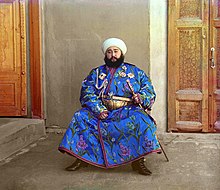Khalat

A khalat or chalat (Persian: خلعت / ALA-LC : xalʿat), also khilat ( chilat ), is a long-sleeved robe made of silk or cotton that is worn by men and women in various styles in Central Asia, Iran, Pakistan and northern India .
In Persia the chalat consists of a long, wide outer garment made of cloth, in its time "worth 20 to 100, even up to 200 ducats", in Central Asia it consists of a wide, long-sleeved outer garment made of colorful silk or cloth. Meyers Konversationslexikon says: " Chilat is a precious dress that the princes of Persia and Central Asia give as a gift of grace to high officials when there is good news etc. and that is put on by the Shah in Persia with a solemn ceremony (C. pushan) ." The ceremony itself, the award of the robe, was known as the khalat or khilat.
Light-colored spruce sable skins , also traded as American sable, were still often sold to the Orient at the beginning of the 19th century, where, among other things, the haloes of honor that the Sultan gave away were fed with them. Yellow was seen there as the color of the state and power, and so these countries were also buyers of Kolinsky fur, which is in little demand elsewhere because of its natural reddish yellow hue .
In 1841 Carl von Hügel wrote somewhat differently: “Khelat, Khilat or Khalat, the dress of honor that a king gives to a great lord. Usually there is a title associated with it. It usually consists of two shawls, a turban, trousers, gold cloth (kimkham) for a dress, often of jewels and weapons ”.
In Russia after 1812, as part of the return to the Russian roots, Chalat became the name for a thoroughly representative, not necessarily in the style orientalizing robe in which guests could also be received. The portrait of Pushkin made by Tropinin in 1827 shows the poet in a fashionable, contemporary style in a noble, silk-lined chalat.
Turkish khalat from the Kunstkammer in St. Petersburg
See also
literature
- Stewart Gordon (Ed.): Robes of Honor. Khilʾat in Pre-Colonial and Colonial India. Oxford University Press, New Delhi et al. 2003, ISBN 0-19-566322-5 .
- Chalat. In: Meyers Konversations-Lexikon . An encyclopedia of common knowledge. Volume 3: Leaf Beetles - Chimbote. 4th, completely revised edition. Verlag des Bibliographisches Institut, Leipzig 1886, p. 918.
Individual evidence
- ^ Meyers Konversations-Lexikon. An encyclopedia of common knowledge. Volume 3: Leaf Beetles - Chimbote. 4th, completely revised edition. Verlag des Bibliographisches Institut, Leipzig 1886, p. 918.
- ↑ Emil Brass : From the realm of fur. 2nd improved edition. Publishing house of the "Neue Pelzwaren-Zeitung and Kürschner-Zeitung", Berlin 1925, p. 576.
- ↑ Fritz Schmidt: The book of the fur animals and fur. FC Mayer Verlag, Munich 1970, p. 281.
- ↑ Carl Freiherr von Hügel : Kashmir and the Empire of the Siek. Volume 4, Department 1. Hallberger, Stuttgart 1842, p. 131 .
- ↑ Orlando Figes : Natascha's Dance. A cultural history of Russia. Berlin-Verlag, Berlin 2003, ISBN 3-8270-0487-X , p. 135.
